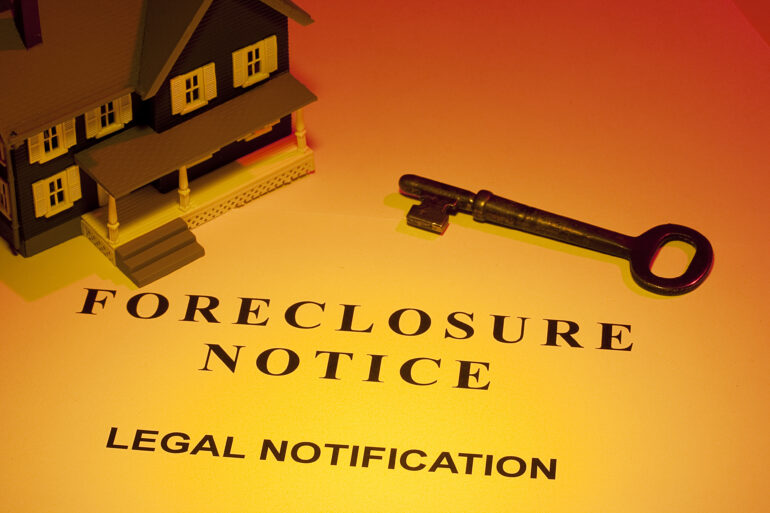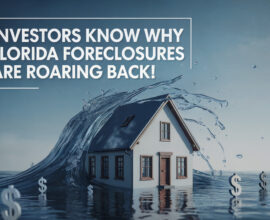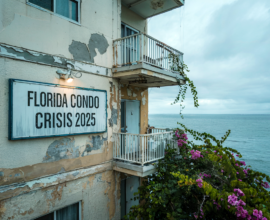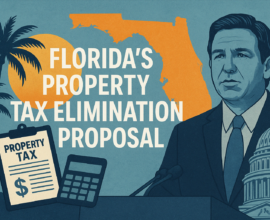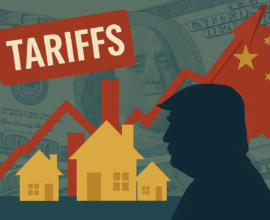Are Foreclosures up in 2022?
While the impacts of COVID-19 aren’t entirely gone, many people believe that life is returning to normal. For many, that means restaurants are open, schools are back to in-person sessions, and the economy is finding some kind of balance. Returning to “normal” doesn’t come without some growing pains, however.
Foreclosures in the first half of 2022 are up 219% across the United States annually. 90% of those foreclosures took place in major metro areas. While the highest number of people impacted is in Illinois, New Jersey, and Ohio, Florida is also seeing some shocking numbers.
The number of foreclosures in January alone was up 29% in the Sunshine State from the previous month and 139% year over year. Florida had the sixth highest number of foreclosures in the first six months of 2022. In regards to metro areas (cities with a population of at least 200,000 residents), both Jacksonville (third) and Lakeland (seventh) made the top ten list of cities experiencing higher foreclosure rates.
Merely recognizing that foreclosure rates have increased during the first half of 2022 doesn’t necessarily explain what’s happening and what, if anything, real estate investors should do to thrive through these abnormal times.
How Did We Get Here?
The last couple of years have been like a chapter out of a dystopian novel. When COVID-19 hit, the world came to a practical freeze. To help people get through these trying times, mortgage rates dramatically dropped. At the same time, companies explored work-from-home options that helped keep things going.
With greater buying power and the ability to work from anywhere, many people decided to move away from crowded cities, regions with strict rules, or higher cost-of-living areas to find safety and freedom elsewhere. While Florida’s sandy beaches, year-round warm weather, and lack of state taxes have always made it a popular place to live, it has become the primary relocation destination.
In 2020, Florida ranked as the number one state for relocation. Of the 8.9 million people who took up a new residence, 28% hung their hats in Florida. That trend continues with 329,717 new Floridians from April 2020 to April 2021. The expected trend is that Florida will see 845+ new residents daily for the next few years.
While this kind of growth is typically viewed positively, one thing got in the way: a national housing shortage. The pandemic didn’t just open the doors and desires for people to move; it also led to material scarcity, supply-line delays, and worker insufficiencies. Builders couldn’t keep up with the demand. At the same time, many homeowners took advantage of the reduced interest rates to refinance, which meant they were in no hurry to sell. Some would-be sellers decided to wait out of fear of crowded open houses.
Everyone’s business 101 class covers the simple idea of supply and demand. When there is a high demand for something with a low supply, prices will rise. Even before the pandemic, homes were in high demand. In fact, more than 72 million millennials were looking to purchase homes in 2020.
In Florida, the median sale price for a single-family home has jumped by 81% in the last five years and is expected to continue at a similar rate for the next five years. Areas like Miami and Tampa saw the largest number of buyers and the fewest number of available houses.
The Rise in Foreclosures Is Not What You Think
It’s easy to imagine that so many houses are returning to the banks because of the high demand for homes during the pandemic. This trend reminds many investors of the 2007-2008 financial crisis. After the bubble burst, millions of homeowners owed more on their mortgages than their homes were worth. More than 3.1 million foreclosure filings were made in 2008, 41% more than the previous year.
The difference between the crisis of 2008 and today is that cheap credit and lax lending standards led people to buy houses they couldn’t actually afford. These practices led to a higher demand for housing that inflated the market. Modern lending practices are much more strict, which helps ensure that borrowers can afford the homes they want to buy.
Most of the foreclosures we’re seeing today are foreclosures that started before the pandemic. With COVID-19 turning the world upside down, the government put a foreclosure and eviction moratorium into place. If it were not for this government protection order, most of these homes would have foreclosed two years ago. There is very little delinquency or defaults on recently purchased homes.
Foreclosure data shows that foreclosures in 2021 were down 29% from 2020 and down 95% from the previous ten years. 2021 actually showed the lowest level of foreclosures since data started being collected in 2005.
Now that the moratoriums are over, foreclosures are resuming. The jump we’re seeing today comes from catching up on the backlog before the pandemic. The numbers only seem high today because they were so low over the past two years. We’re not back at the actual number of foreclosures in 2019 before the pandemic started doing its damage.
What Does the Increased Number of Foreclosures Mean for the Market?
The first and most apparent thing to recognize from the uptick in foreclosures is that the regulatory protections stopping foreclosures are over. Of course, not every homeowner who was forbearance of default will go through foreclosure this year, and many people were able to get caught back up on their payments over the last two years. For those who couldn’t get back on their feet, the bank will come knocking soon.
The most significant impact an increase in foreclosures will have on the market is that some new houses may be available for purchase. Of course, there is still a shortage of available homes in popular areas. Supply and demand control housing prices, so homebuyers shouldn’t expect to buy a foreclosed house at a crazy discount. There will be enough competition for available housing that prices aren’t likely to fall. In fact, it would take an influx of new units on the market for the supply to get large enough to reduce prices.
Is Now a Good Time to Buy?
Real estate investors across Florida wonder if now is an excellent time to increase their portfolios. While no one necessarily wants to gain from someone else’s calamity, there may be a few new properties available in your area. There are a few things to consider before going foreclosure shopping.
1. Examine Your Financial Situation
Mortgage rates have already increased by two points in 2022 alone, nearly double the rate from last year. Fixed-rate mortgages hit 5.81% in June before they started leveling at 5.3% in July. With the increasing inflation levels, the Fed is likely to raise rates again. Some people, like Chief Economist Lawrence Yun of the National Association of Realtors (NAR), predict that rates could hit as high as 7% by the end of the year. Higher rates and more expensive real estate doesn’t mean there aren’t options.
For example, it might be time to invest in a Delaware Statutory Trust (DST). These trusts allow investors to take fractional ownership in commercial real estate like multi-family homes and other rental properties.
In Miami, the average rent saw a 38% increase in 2022, and Orlando saw a 20% increase for the year, which is 7% higher than the national average. Investing in a rental property without taking on the burden of entirely purchasing could result in an excellent ROI. Top rental management companies are reporting an ROI between 8% and 12% in 2022, which is much higher than the 1%-2% often seen with rental properties.
Regardless of whether you decide to invest in a DST or other trust or go after purchasing foreclosed homes, you must consider rising rates in your investment strategies. These rates give you less buying power and will result in higher monthly payments than in the past.
Fannie Mae predicts that home prices will be up to 10.8% for the year, but this kind of prediction continually changes (experts forecasted that mortgage rates in 2022 would only hit 3.6%, which was extremely far off target). You want to ensure your finances are in order before making bids and know what to expect moving forward.
2. Understand the Different Types of Foreclosures
When houses are listed for sale on the MLS as foreclosures, there are different types to consider depending on the stage of the process.
- Pre-foreclosure: when the lender notifies the homeowner that they are in default. The homeowner still has time to make up the payments and keep their homes.
- Short sales: when the homeowner tries to sell the home for less than the mortgage is worth, often due to financial distress.
- Sheriff’s sale: this is an auction where properties in default are sold at a courthouse.
- Bank foreclosures (REO): homes that now belong to the bank and are not for sale.
- Government foreclosures: properties purchased with loans from the Federal Housing Finance Agency or Veterans Administration.
The type of foreclosure can affect how the home will sell. For example, banks often sell REO homes quickly to get back their investment. Of course, banks are also aware of the current market and want to get as much back from the foreclosed property as possible.
On the other hand, buying a government-owned home can be a time-consuming and lengthy process due to the bureaucratic speed of the involved agencies. Buying a property at auction means paying cash and being responsible for the title, taxes, and insurance, even if something goes wrong with the property.
Only you can determine which types of foreclosures are worth pursuing and how much risk you can take on.
3. Due Diligence Is a Must
Even if you can find a great deal on a foreclosed home in this competitive market, you might be biting off more than you expect. That’s why it’s essential to take advantage of every opportunity for an inspection available.
Keep in mind that nearly all foreclosures are sold “as is.” That means you will be responsible for all inspections and repairs. Lenders, short sellers, and government agencies will not negotiate the price on an “as is” home based on the inspection. In some cases, like with HUD-owned homes, an inspection cannot be used to cancel a bid.
While a home inspection can provide invaluable information about the state of a home, it may not be able to give you all of the information you want. In many cases, foreclosed homes have their utilities turned off, which makes it impossible for an inspector to check the electrical, HVAC, and plumbing systems. If you go through with the purchase, repairing these systems, if damaged, could cost a small fortune.
There are a few things you should consider when looking at foreclosed homes:
- How long has it been vacant?
- Has it been vandalized by disgruntled homeowners, thieves, etc.?
- Have there been squatters or trespassers?
- Were there renovations performed that may need to be redone?
- Does it appear that the house was maintained or neglected?
There are no right or wrong answers to these questions, but they can help you better assess the situation.
Only Time Will Tell
Right now, it’s clear that home foreclosures are on the rise. It’s unclear if the current numbers will surpass pre-pandemic numbers or will just catch up to “normal.” Since most of these foreclosures are just banks catching up on backlogged defaults, the increase isn’t a sign of a coming financial crisis or housing bubble. Instead, the increased foreclosure rate is more a sign of the market finding balance.
While the housing market is still very competitive, foreclosed homes could interject much-needed inventory. This may not significantly alter the rising trend of homes, but it could provide opportunities for investors to purchase properties or join property trusts.
The most challenging part of the current market is that no one can necessarily predict what will happen or when. That’s why real estate investors must understand the rising rates, prices, and competition before buying a foreclosed property. For those who are careful, cautious, and conscious, the current market could lead to incredible gains and opportunities.
